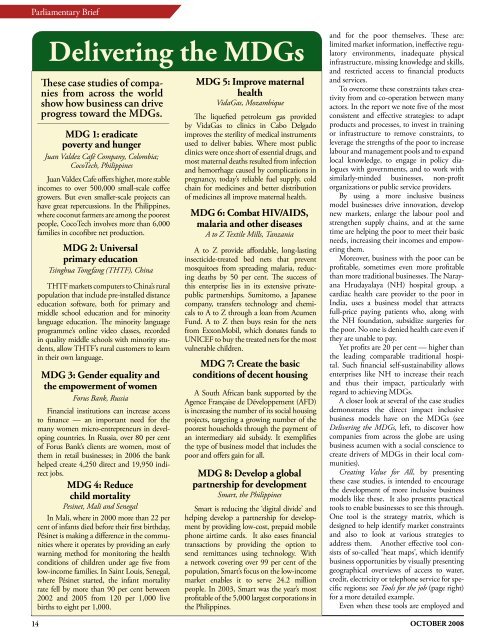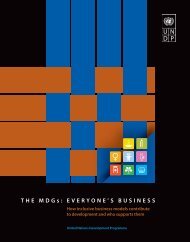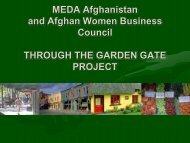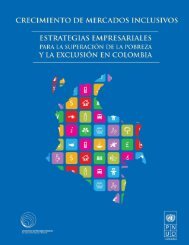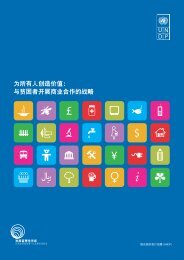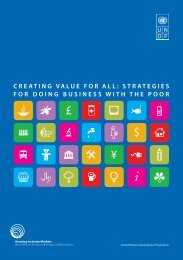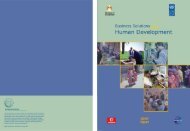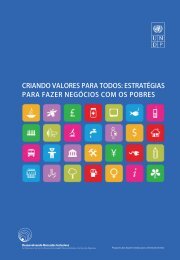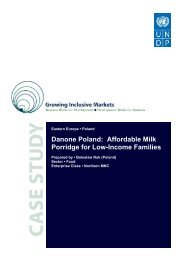Meet the consumer today's business needs to targe
Meet the consumer today's business needs to targe
Meet the consumer today's business needs to targe
- No tags were found...
You also want an ePaper? Increase the reach of your titles
YUMPU automatically turns print PDFs into web optimized ePapers that Google loves.
Parliamentary Brief14Delivering <strong>the</strong> MDGsThese case studies of companiesfrom across <strong>the</strong> worldshow how <strong>business</strong> can driveprogress <strong>to</strong>ward <strong>the</strong> MDGs.MDG 1: eradicatepoverty and hungerJuan Valdez Café Company, Colombia;CocoTech, PhilippinesJuan Valdex Cafe offers higher, more stableincomes <strong>to</strong> over 500,000 small-scale coffeegrowers. But even smaller-scale projects canhave great repercussions. In <strong>the</strong> Philippines,where coconut farmers are among <strong>the</strong> poorestpeople, CocoTech involves more than 6,000families in cocofibre net production.MDG 2: Universalprimary educationTsinghua Tongfang (THTF), ChinaTHTF markets computers <strong>to</strong> China’s ruralpopulation that include pre-installed distanceeducation software, both for primary andmiddle school education and for minoritylanguage education. The minority languageprogramme’s online video classes, recordedin quality middle schools with minority students,allow THTF’s rural cus<strong>to</strong>mers <strong>to</strong> learnin <strong>the</strong>ir own language.MDG 3: Gender equality and<strong>the</strong> empowerment of womenForus Bank, RussiaFinancial institutions can increase access<strong>to</strong> finance — an important need for <strong>the</strong>many women micro-entrepreneurs in developingcountries. In Russia, over 80 per cen<strong>to</strong>f Forus Bank’s clients are women, most of<strong>the</strong>m in retail <strong>business</strong>es; in 2006 <strong>the</strong> bankhelped create 4,250 direct and 19,950 indirectjobs.MDG 4: Reducechild mortalityPesinet, Mali and SenegalIn Mali, where in 2000 more than 22 percent of infants died before <strong>the</strong>ir first birthday,Pésinet is making a difference in <strong>the</strong> communitieswhere it operates by providing an earlywarning method for moni<strong>to</strong>ring <strong>the</strong> healthconditions of children under age five fromlow-income families. In Saint Louis, Senegal,where Pésinet started, <strong>the</strong> infant mortalityrate fell by more than 90 per cent between2002 and 2005 from 120 per 1,000 livebirths <strong>to</strong> eight per 1,000.MDG 5: Improve maternalhealthVidaGas, MozambiqueThe liquefied petroleum gas providedby VidaGas <strong>to</strong> clinics in Cabo Delgadoimproves <strong>the</strong> sterility of medical instrumentsused <strong>to</strong> deliver babies. Where most publicclinics were once short of essential drugs, andmost maternal deaths resulted from infectionand hemorrhage caused by complications inpregnancy, <strong>to</strong>day’s reliable fuel supply, coldchain for medicines and better distributionof medicines all improve maternal health.MDG 6: Combat HIV/AIDS,malaria and o<strong>the</strong>r diseasesA <strong>to</strong> Z Textile Mills, TanzaniaA <strong>to</strong> Z provide affordable, long-lastinginsecticide-treated bed nets that preventmosqui<strong>to</strong>es from spreading malaria, reducingdeaths by 50 per cent. The success ofthis enterprise lies in its extensive privatepublicpartnerships. Sumi<strong>to</strong>mo, a Japanesecompany, transfers technology and chemicals<strong>to</strong> A <strong>to</strong> Z through a loan from AcumenFund. A <strong>to</strong> Z <strong>the</strong>n buys resin for <strong>the</strong> netsfrom ExxonMobil, which donates funds <strong>to</strong>UNICEF <strong>to</strong> buy <strong>the</strong> treated nets for <strong>the</strong> mostvulnerable children.MDG 7: Create <strong>the</strong> basicconditions of decent housingA South African bank supported by <strong>the</strong>Agence Française de Développement (AFD)is increasing <strong>the</strong> number of its social housingprojects, <strong>targe</strong>ting a growing number of <strong>the</strong>poorest households through <strong>the</strong> payment ofan intermediary aid subsidy. It exemplifies<strong>the</strong> type of <strong>business</strong> model that includes <strong>the</strong>poor and offers gain for all.MDG 8: Develop a globalpartnership for developmentSmart, <strong>the</strong> PhilippinesSmart is reducing <strong>the</strong> ‘digital divide’ andhelping develop a partnership for developmentby providing low-cost, prepaid mobilephone airtime cards. It also eases financialtransactions by providing <strong>the</strong> option <strong>to</strong>send remittances using technology. Witha network covering over 99 per cent of <strong>the</strong>population, Smart’s focus on <strong>the</strong> low-incomemarket enables it <strong>to</strong> serve 24.2 millionpeople. In 2003, Smart was <strong>the</strong> year’s mostprofitable of <strong>the</strong> 5,000 largest corporations in<strong>the</strong> Philippines.and for <strong>the</strong> poor <strong>the</strong>mselves. These are:limited market information, ineffective regula<strong>to</strong>ryenvironments, inadequate physicalinfrastructure, missing knowledge and skills,and restricted access <strong>to</strong> financial productsand services.To overcome <strong>the</strong>se constraints takes creativityfrom and co-operation between manyac<strong>to</strong>rs. In <strong>the</strong> report we note five of <strong>the</strong> mostconsistent and effective strategies: <strong>to</strong> adaptproducts and processes, <strong>to</strong> invest in trainingor infrastructure <strong>to</strong> remove constraints, <strong>to</strong>leverage <strong>the</strong> strengths of <strong>the</strong> poor <strong>to</strong> increaselabour and management pools and <strong>to</strong> expandlocal knowledge, <strong>to</strong> engage in policy dialogueswith governments, and <strong>to</strong> work withsimilarly-minded <strong>business</strong>es, non-profi<strong>to</strong>rganizations or public service providers.By using a more inclusive <strong>business</strong>model <strong>business</strong>es drive innovation, developnew markets, enlarge <strong>the</strong> labour pool andstreng<strong>the</strong>n supply chains, and at <strong>the</strong> sametime are helping <strong>the</strong> poor <strong>to</strong> meet <strong>the</strong>ir basic<strong>needs</strong>, increasing <strong>the</strong>ir incomes and empowering<strong>the</strong>m.Moreover, <strong>business</strong> with <strong>the</strong> poor can beprofitable, sometimes even more profitablethan more traditional <strong>business</strong>es. The NarayanaHrudayalaya (NH) hospital group, acardiac health care provider <strong>to</strong> <strong>the</strong> poor inIndia, uses a <strong>business</strong> model that attractsfull-price paying patients who, along with<strong>the</strong> NH foundation, subsidize surgeries for<strong>the</strong> poor. No one is denied health care even if<strong>the</strong>y are unable <strong>to</strong> pay.Yet profits are 20 per cent — higher than<strong>the</strong> leading comparable traditional hospital.Such financial self-sustainability allowsenterprises like NH <strong>to</strong> increase <strong>the</strong>ir reachand thus <strong>the</strong>ir impact, particularly withregard <strong>to</strong> achieving MDGs.A closer look at several of <strong>the</strong> case studiesdemonstrates <strong>the</strong> direct impact inclusive<strong>business</strong> models have on <strong>the</strong> MDGs (seeDelivering <strong>the</strong> MDGs, left, <strong>to</strong> discover howcompanies from across <strong>the</strong> globe are using<strong>business</strong> acumen with a social conscience <strong>to</strong>create drivers of MDGs in <strong>the</strong>ir local communities).Creating Value for All, by presenting<strong>the</strong>se case studies, is intended <strong>to</strong> encourage<strong>the</strong> development of more inclusive <strong>business</strong>models like <strong>the</strong>se. It also presents practical<strong>to</strong>ols <strong>to</strong> enable <strong>business</strong>es <strong>to</strong> see this through.One <strong>to</strong>ol is <strong>the</strong> strategy matrix, which isdesigned <strong>to</strong> help identify market constraintsand also <strong>to</strong> look at various strategies <strong>to</strong>address <strong>the</strong>m. Ano<strong>the</strong>r effective <strong>to</strong>ol consistsof so-called ‘heat maps’, which identify<strong>business</strong> opportunities by visually presentinggeographical overviews of access <strong>to</strong> water,credit, electricity or telephone service for specificregions; see Tools for <strong>the</strong> job (page right)for a more detailed example.Even when <strong>the</strong>se <strong>to</strong>ols are employed andOCTOBER 2008


